For the 2025 school year, there are 2 public middle schools serving 709 students in Wapato School District. This district's average middle testing ranking is 1/10, which is in the bottom 50% of public middle schools in Washington.
Public Middle Schools in Wapato School District have an average math proficiency score of 11% (versus the Washington public middle school average of 36%), and reading proficiency score of 22% (versus the 51% statewide average).
Minority enrollment is 99% of the student body (majority Hispanic), which is more than the Washington public middle school average of 50% (majority Hispanic).
Overview
This School District
This State (WA)
# Schools
11 Schools
800 Schools
# Students
3,196 Students
302,560 Students
# Teachers
205 Teachers
16,189 Teachers
Student : Teacher Ratio
15:1
15:1
District Rank
Wapato School District, which is ranked within the bottom 50% of all 306 school districts in Washington (based off of combined math and reading proficiency testing data) for the 2021-2022 school year.
The school district's graduation rate of 83% has increased from 70-74% over five school years.
Overall District Rank
#296 out of 307 school districts
(Bottom 50%)
(Bottom 50%)
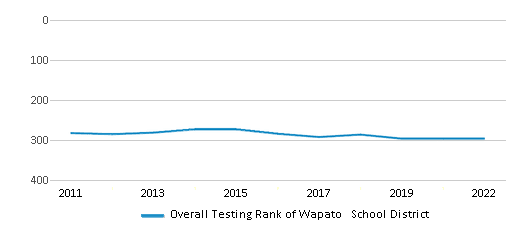
Math Test Scores (% Proficient)
13%
40%
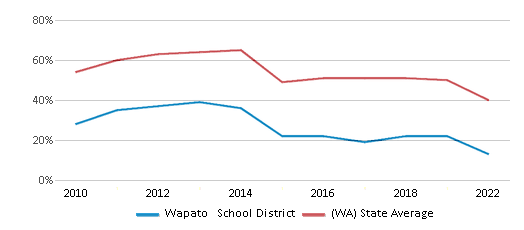
Reading/Language Arts Test Scores (% Proficient)
24%
53%
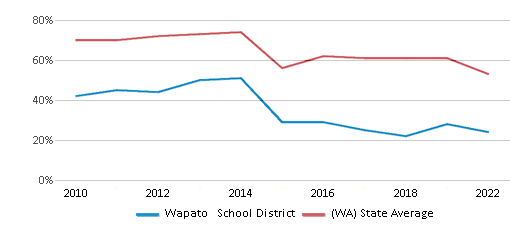
Science Test Scores (% Proficient)
18%
49%
Graduation Rate
83%
84%
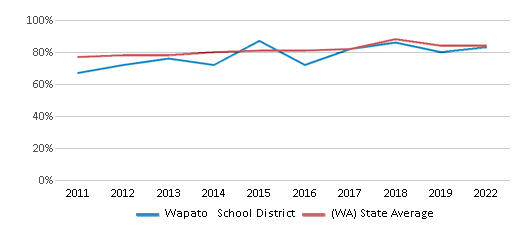
Students by Ethnicity:
Diversity Score
0.38
0.68
# American Indian Students
542 Students
5,703 Students
% American Indian Students
17%
2%
# Asian Students
60 Students
23,666 Students
% Asian Students
2%
8%
# Hispanic Students
2,470 Students
73,370 Students
% Hispanic Students
77%
25%
# Black Students
10 Students
13,426 Students
% Black Students
n/a
5%
# White Students
59 Students
148,736 Students
% White Students
2%
50%
# Hawaiian Students
2 Students
3,970 Students
% Hawaiian Students
n/a
1%
# Two or more races Students
52 Students
26,275 Students
% of Two or more races Students
2%
9%
Students by Grade:
# Students in PK Grade:
33
1,563
# Students in K Grade:
281
3,945
# Students in 1st Grade:
237
4,184
# Students in 2nd Grade:
247
4,295
# Students in 3rd Grade:
204
4,473
# Students in 4th Grade:
224
4,820
# Students in 5th Grade:
263
7,072
# Students in 6th Grade:
240
71,936
# Students in 7th Grade:
232
81,343
# Students in 8th Grade:
237
82,029
# Students in 9th Grade:
238
11,117
# Students in 10th Grade:
279
8,145
# Students in 11th Grade:
205
8,299
# Students in 12th Grade:
276
9,339
# Ungraded Students:
-
-
District Revenue and Spending
The revenue/student of $17,302 in this school district is less than the state median of $18,796. The school district revenue/student has stayed relatively flat over four school years.
The school district's spending/student of $16,798 is less than the state median of $19,246. The school district spending/student has stayed relatively flat over four school years.
Total Revenue
$55 MM
$20,715 MM

Spending
$54 MM
$21,212 MM

Revenue / Student
$17,302
$18,796
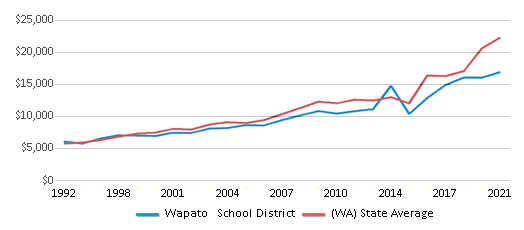
Spending / Student
$16,798
$19,246

Best Wapato School District Public Middle Schools (2025)
School
(Math and Reading Proficiency)
(Math and Reading Proficiency)
Location
Grades
Students
Rank: #11.
Wapato Middle School
(Math: 11% | Reading: 22%)
Rank:
Rank:
1/
Bottom 50%10
1309 Kateri Lane
Wapato, WA 98951
(509) 877-2173
Wapato, WA 98951
(509) 877-2173
Grades: 6-8
| 701 students
Rank: n/an/a
212 W 3rd St
Wapato, WA 98951
(509) 877-4181
Wapato, WA 98951
(509) 877-4181
Grades: 6-8
| 8 students
Recent Articles

Year-Round Or Traditional Schedule?
Which is more appropriate for your child? A year-round attendance schedule or traditional schedule? We look at the pros and cons.

Why You Should Encourage Your Child to Join a Sports Team
Participating in team sports has a great many benefits for children, there is no doubt. In this article you will learn what those benefits are.

White Students are Now the Minority in U.S. Public Schools
Increasing birth rates among immigrant families from Asia and Central and South America, combined with lower birth rates among white families, means that for the first time in history, public school students in the United States are majority-minority. This shift in demographics poses difficulties for schools as they work to accommodate children of varying language abilities and socio-economic backgrounds.





